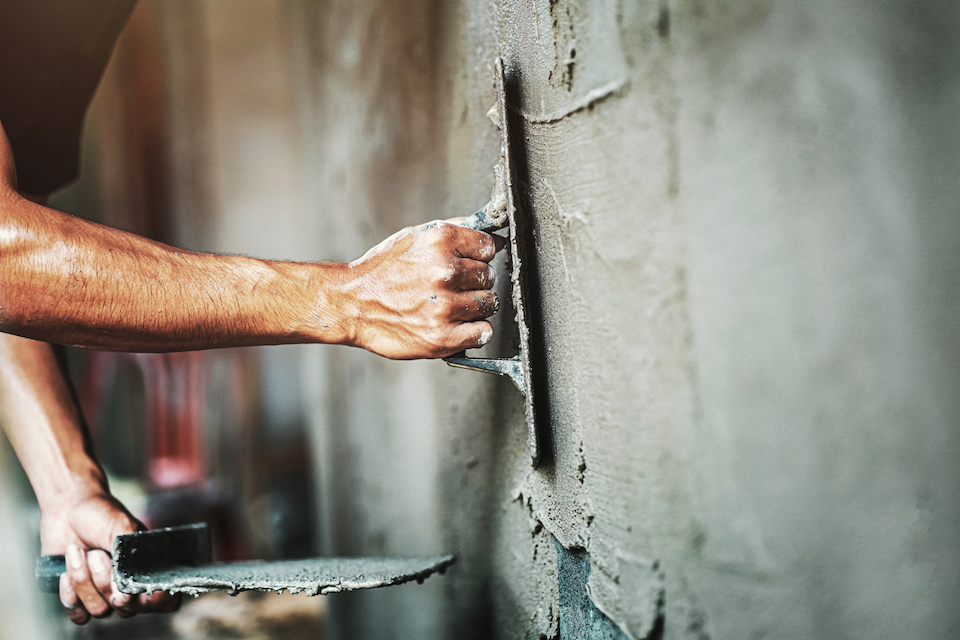How Much Does It Cost to Plaster a Ceiling in 2025?
Want to know how much you'd need to pay for a ceiling covered with plaster?
If the plaster on your walls or ceiling is cracked, then it's a good time to replaster!
Let’s get right to it…
The average cost of plastering a ceiling is £200 to £450. However, the cost will really depend on the size of the ceiling and the method used with the aforementioned price just being an average.
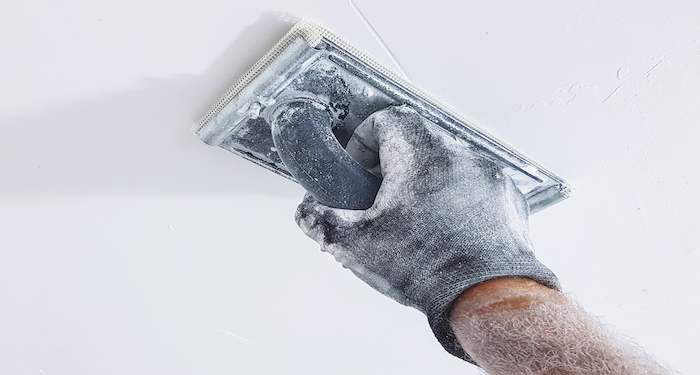
Having old or damaged plaster renewed will provide a fresh and smooth new look, which in turn gives you better options when it comes to decorating.
Applying plasterboard to a ceiling would cost about £200 to £300 for a small ceiling, with the price rising to £500 to £750 for a larger area. It is also worth mentioning fire-rated plasterboard is required in areas such as kitchens and garages, which can be slightly more expensive.
In the case of wet plaster, for this you’d need to budget for about £150 to £200 for a small ceiling, £200 to £300 for a medium ceiling, or £300 to £400 for a large ceiling.
Alternatively, a plasterer could apply a skim coat starting from as little as £100, or instead of removing old plaster, have plasterboard fixed directly over the existing ceiling.
The overall fee will vary depending on factors such as the size and condition of the ceiling and how many tradespeople need to be hired.
Cost to Plaster a Ceiling (2025)
Plasterboard Ceiling Prices
| Size of Ceiling | Cost per m² | Total Cost |
|---|---|---|
|
Small - 12 m² |
£16 to £25 |
£200 to £300 |
|
Medium - 20 m² |
£15 to £22.50 |
£300 to £450 |
|
Large - 35 m² |
£14.50 to £21 |
£500 to £750 |
Wet Plastering Ceiling Prices
| Size of Ceiling | Cost per m² | Total Cost |
|---|---|---|
|
Small - 12 m² |
£12 to £16 |
£150 to £200 |
|
Medium - 20 m² |
£10 to £15 |
£200 to £300 |
|
Large - 35 m² |
£8.50 to £11.50 |
£300 to £400 |
- How Much Does It Cost to Plaster a Ceiling in 2025?
- Supply Costs of Plastering a Ceiling
- Additional Costs of Plastering a Ceiling
- Labour Cost to Plaster a Ceiling
- How Long Plastering a Ceiling Usually Takes
- Types of Ceiling Plaster
- Alternative Ceiling Finishes
- Advantages of Plastering a Ceiling
- Cost to Remove Plaster from a Ceiling
- FAQs
- Sources
Supply Costs of Plastering a Ceiling
The following costs are the expenses involved in purchasing the necessary materials (hence for this section we’re excluding the labour cost and any other expenses like that of waste removal).
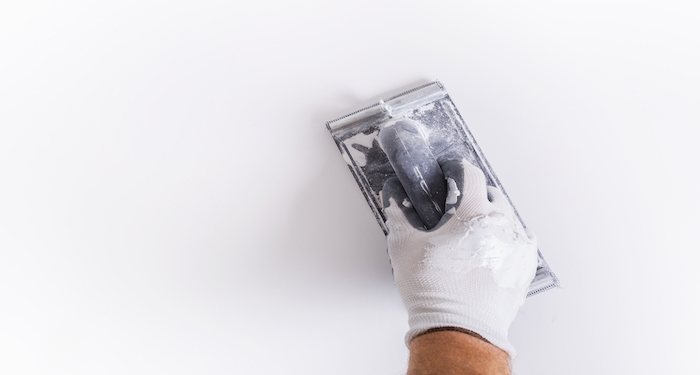
Of course, these costs would be especially relevant to those who wish to undertake this work DIY.
For starters, plasterboard is priced at really anywhere from £10 to £65 per board. It’s unlikely to fall outside of this range but the price will largely depend on the quality as is the case with other materials.
Speaking of which, undercoat plaster costs around £0.50 to £2 per kg, multi-finish plaster is priced at £0.30 to £0.40 per kg, and finish plaster would set you back £5 to £6 per kg in most cases.
What about the overall fee then?
The overall fee will depend on a range of factors, including:
- Size of ceiling
- Condition of ceiling
- Location
- Number of tradespeople hired
- Materials
- Property location
- Ease of access
Additional Costs of Plastering a Ceiling
As with any work, additional fees can be incurred. Let’s take a look at some common examples that may apply when having a ceiling plastered.
Ceiling Damage
One of the main reasons you may need to plaster a ceiling, is if there has been ceiling damage due to reasons such as damp and condensation, cracks, sagging or mould.
The cost to repair ceiling damage typically ranges from £100 to £400, depending on the extent of the damage and the materials required.
Further Plastering
You may wish to have more than just the ceiling plastered. Plastering costs can vary significantly depending on the type of job, from plastering one wall to a decorative plastering ceiling.
Here are some common examples:
- Plastering a wall - £150 to £250
- Plastering two walls - £300 to £500
- Plastering an entire room - £300 to £900
- Plaster ceiling roses - £150 to £400
Fitting Drywall or Plasterboard
If you have noticed imperfections or faults with your interior walls, this could be the time to fix these too with new plasterboard or drywalls. Fitting Drywall or Plasterboard an average room will cost around £750.
Coving
When plastering a ceiling it is always best to fit coving after the job has been completed.
This ensures the plastering is done right up to the wall and normally costs between £25 and £30 per metre. If you already have coving installed, you may want to get this removed beforehand. You would then need to factor in the additional cost of getting new coving fitted.
Size and Style of Ceiling
Another important consideration is how large the ceiling is. The larger the ceiling, the more work will be required (as such, you can expect a higher labour cost) which will also impact the overall cost of materials.
Likewise, rooms with complex angles or limited access may have an impact on the price - as to will period properties whereby specialist materials such as lime plaster may be required.
Condition of Ceiling
The state of the ceiling is also relevant to the total cost. The reason for this is that a more worn-down ceiling may need more work before it can be plastered while a ceiling in a good state would not.

Painting a Room
Once the plaster has dried, you may decide to have it painted, in which case the average cost based on a 15m2 room is around £260 to £270. Although the total cost to paint a room depends on if you're doing the coving and skirting boards at the same time, along with other factors that include the type of paint and overall area that requires redecorating.
Number of Tradespeople Hire
The number of tradespeople required can affect the overall labour costs. In many cases plastering a ceiling is often manageable by one person. While a larger team has the potential to complete a job more efficiently, there's the added expense of hiring the extra workers to consider.
Duration
The time it takes to plaster a ceiling can also influence the overall cost, especially if the plasterer charges by the hour. If a daily rate applies, then expect to be charged around £125 to £225 per day (albeit higher in the likes of London and the South East).
If the work is likely to take more than a day to complete, any quotes received should reflect this, some may reflect the cost of the complete job rather than based on the time required.
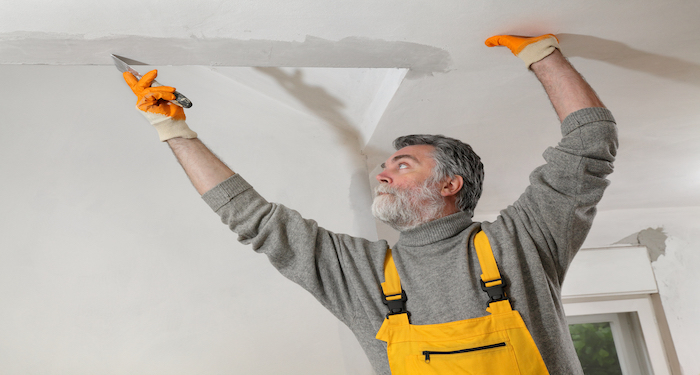
Labour Cost to Plaster a Ceiling
We’ll now look at the labour costs in particular. These exclude the cost of supplies and waste removal.
In the majority of cases, the pricing is pretty straightforward in that a labourer will charge a daily rate of about £125 to £175, although this is likely to be higher in areas such as London and the South East.
With that being said, the price may rise to approximately £175 to £225 a day if the plastering turns out to be more challenging than it would be in most cases.
In the event the job requires only a couple of hours work, a plasterer may still charge a minimum rate that's more in line with their full day rate.
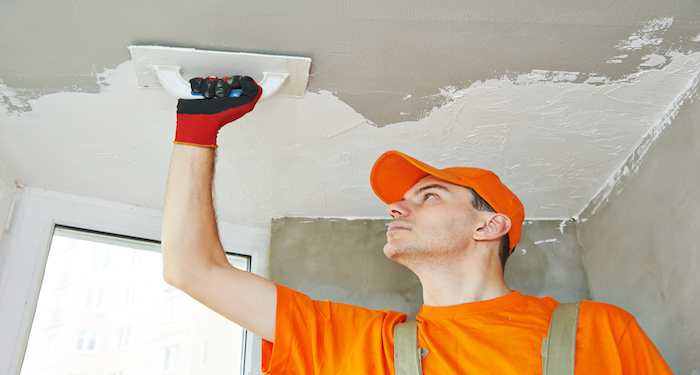
How Long Plastering a Ceiling Usually Takes
We’ll now take a look at the time frames involved in plastering a ceiling.
On average, it takes about a day to plaster a ceiling although the duration can vary based on a range of factors such as the size of the ceiling, ease of access, number of tradespeople hired, and the state of the ceiling.
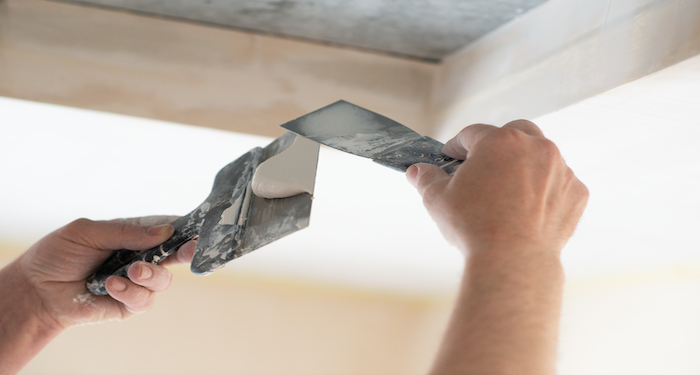
The work itself may last around 4-8 hours but preparation should only make up a fraction of the total duration.
Types of Ceiling Plaster
As you’d expect, there are many types of ceiling plaster available on the market and usually the differentiating factor is design. Let’s have a look at some examples.
Prices may vary but broadly speaking they will be the same as listed in the first section since we are talking about design differences with similar material costs.
Lime and Gypsum Plaster
Many older properties come with this type of ceiling but it may still interest you for its retro design. This type of plaster was often mixed with sand, animal hair, and even hay for improved frit and durability.
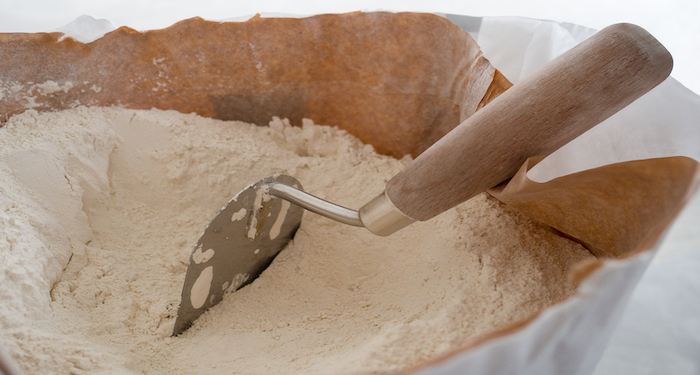
However, its properties have evolved over time. Many now opt for gypsum prefab sheet rock instead.
Pros
- Retro look
Cons
- Not common today
- Difficult to source
Popcorn Ceilings
These ceilings consist of a spray-on material, often containing the likes of polystyrene or vermiculite. While they are not technically plaster, they are popular for hiding slight imperfections and can also help with noise insulation.
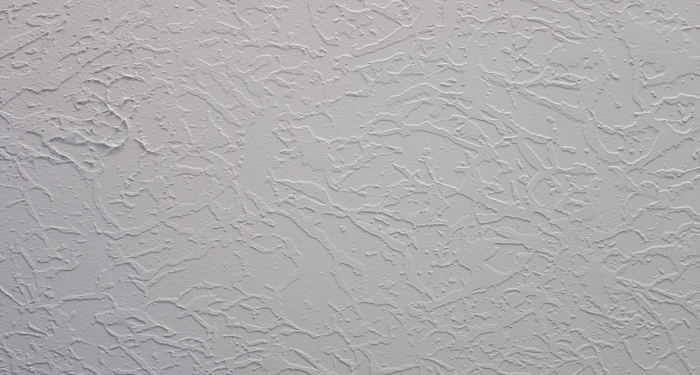
The reason for its ‘popcorn’ aesthetic is that these ceilings are not smoothed out after application.
Pros
- Aesthetic may be your cup of tea
Cons
- Not as common
- A little outdated
Skip Trowel
This type of ceiling design is achieved by moving a drywall trowel across the ceiling but with jumps and gaps in its use. The trowel is employed to add tiny quantities of joint compound.
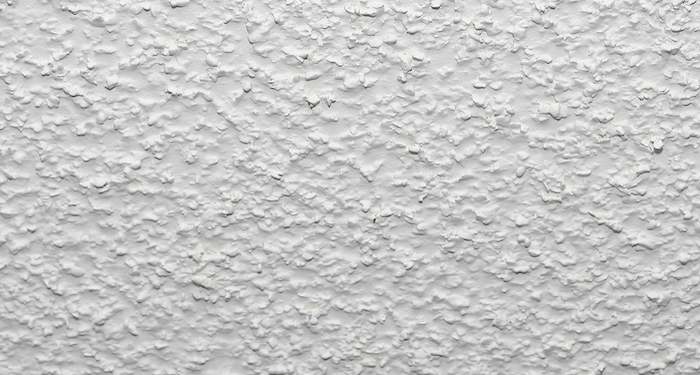
The result is compound peaks which can be knocked away to create a specific texture. This approach is also good for sound insulation.
Pros
- Interesting design
Cons
- Can be difficult to pull off
- Could take long to perform
Alternative Ceiling Finishes
There are a number of alternative ways to change the look of your ceiling without the need of replastering. These include fitting ceiling panels and fitting a suspended false ceiling.
Suspended False Ceilings
Suspended or false ceilingsare usually constructed with plasterboard, offering a quick and cost-effective alternative to traditional plastering. Often found within commercial buildings, they allow for easy access to utilities and give a smooth and modern finish.
Pros
- Fast installation
- Cost effective
- Easy to maintain
Cons
- Loss of room height
- Less aesthetically pleasing
Ceiling Panels
Ceiling panels offer a way to cover you ceiling in a uniform way without the need to worry about repainting or replastering.
Ceiling panels can be installed directly onto a plastered or artexed ceiling as long as it is even and in good condition. Some panels will require a suspended framework.
Wood, such as a pine panelled ceiling, composite, tile, metal, and even fabric, are all options you can consider to make a statement piece out of your ceiling.
Pros
- Can make ceilings more appealing
- Can improve insulation making rooms more energy efficient
Cons
- Longer lasting panels can be expensive
- Cheaper panel options can be easily damaged
Advantages of Plastering a Ceiling
As with any trades work, there are some advantages worth considering. Let’s have a look at the benefits of plastering a ceiling.
Stops Cracking
Plastering a ceiling can repair cracks on the ceiling and reduce the risk of leaks. Prior to the work beginning, cracks will be patched up and sanded over by the contractor before plastering the ceiling. In the long-run, plastering a ceiling can protect the surface and stop cracks from developing in the first place.
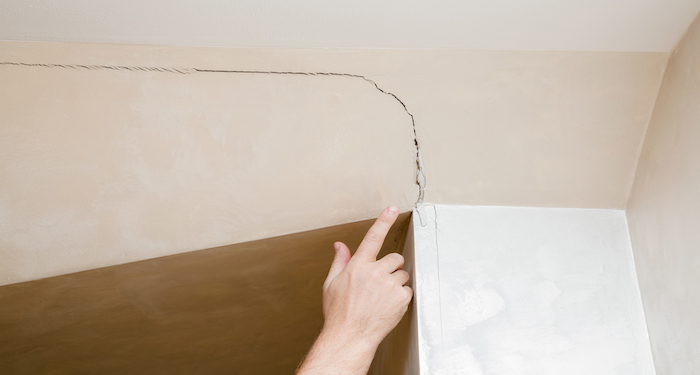
Smoother Look
A key positive to plastering ceilings is that it leaves a pretty smooth look and this only enhances the aesthetic quality of a room. This is a great match if you’ve already had the walls in the room plastered; of course, you could get the entire room plastered at the same time.
Cost to Remove Plaster from a Ceiling
To have plastering removed is likely to take a few hours and cost about £50 to £100 depending on the labour prices involved. This is a rough estimate of course and various factors can come in to play as is the case with plastering a ceiling to begin with.
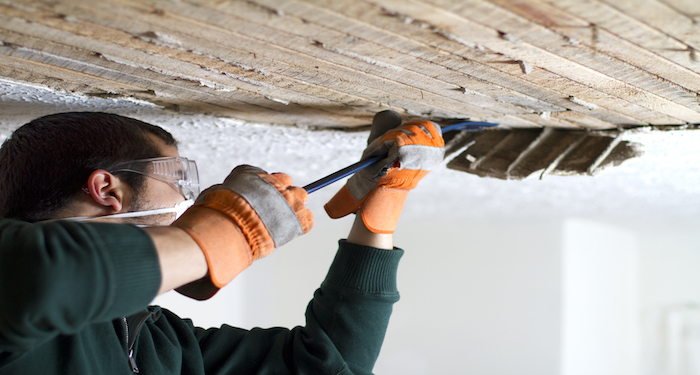
You may wish to have plastering removed from a ceiling as you would like to replace it with an alternative or to have it removed before having fresh plaster added instead.
If you are looking to remove an Artex ceiling, which were popular in 1960s and 1970s builds, it should be handled by a trained professional. This is due to it potentially containing dangerous Asbestos particles. An Asbestos sample survey will need to be carried out prior to work taking place. The cost of removing an artex ceiling can fall anywhere from £400 to £1,950, depending on the size of the ceiling.
FAQs
Q: How do you repair cracks in ceiling plaster?
A: Hairline cracks can be repaired with a filler or joint compound, and are then sanded for a smooth finish. When it comes to larger cracks, it's best to remove any loose material and apply a plaster repair compound, reinforcing it with mesh before finishing the job.
Q: Can you install plasterboard over ceiling plaster?
A: Yes, this is entirely possible but you must take a very specific approach and ensure that you take the correct steps. For instance, you’ll need to be able to determine where the joists are before getting to work. This is ideally a two-person job.
Q: How long does plaster tend to last?
A: Assuming that the surfaces were treated appropriately before application, you can expect plastering to remain good for around about 15-20 years but it will depend on factors such as how well the surface is maintained.
Q: How long does plaster take to dry before a second coat should be added?
A: In most cases, wait about 20–30 minutes, or until the first coat has started to set but is still damp. If you are carrying out the work DIY, always follow the manufacturer’s instructions.
Q: How long after plastering a wall before I can polish it?
A: Polishing usually starts 45–90 minutes after plastering, once the second coat begins to firm up but not completely solid.


